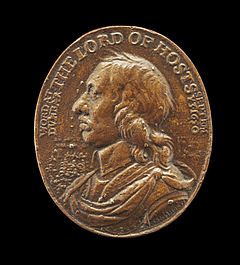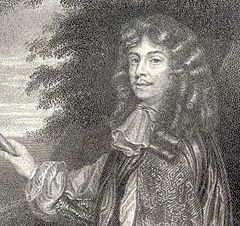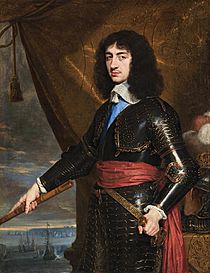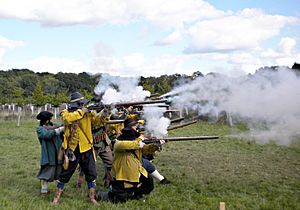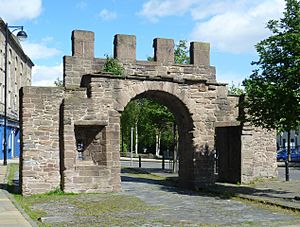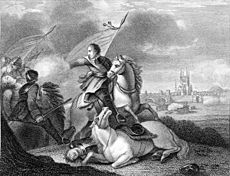Anglo-Scottish war (1650–1652) facts for kids
Quick facts for kids Anglo-Scottish war (1650–1652) |
|||||||||
|---|---|---|---|---|---|---|---|---|---|
| Part of Wars of the Three Kingdoms | |||||||||
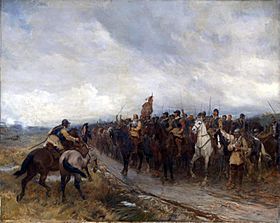 Cromwell at Dunbar, by Andrew Carrick Gow |
|||||||||
|
|||||||||
| Belligerents | |||||||||
| Commanders and leaders | |||||||||
| Oliver Cromwell | |||||||||
The Anglo-Scottish War (1650–1652) was the last big fight in a series of conflicts called the Wars of the Three Kingdoms. These wars involved England, Scotland, and Ireland, with different groups fighting over religion and power. This war started because England wanted to stop Charles II from invading England with a Scottish army.
In 1649, Charles I, the King of England, was executed. England then became a republic, meaning it was ruled by Parliament, not a king. But Scotland, which was a separate kingdom, declared Charles I's son, Charles II, their new king. The Scottish Parliament wanted Charles II to agree to certain rules about religion and government before he could rule. Charles II agreed, and Scotland began building an army to support him.
England's government, called the Commonwealth, felt threatened by Scotland's new army. So, on July 22, 1650, the English army, led by Oliver Cromwell, invaded Scotland. The Scottish army, led by David Leslie, pulled back to Edinburgh and avoided a big battle. After some time, Cromwell surprised the Scots at Dunbar on September 3, defeating them badly. The English then took control of southern Scotland.
In 1651, Charles II and Leslie decided to invade England. They hoped many English people would join them, but few did. Cromwell chased them and defeated their army completely at the Battle of Worcester on September 3, 1651. This battle ended the Wars of the Three Kingdoms. Charles II managed to escape. After this, Scotland became part of the English Commonwealth.
Contents
Why the War Happened
The English Civil Wars
Before this war, England had its own civil wars. These were between King Charles I's supporters (called Royalists) and Parliamentarians, who supported Parliament. Charles I was also King of Scotland. In 1639 and 1640, he fought wars with the Scots because he wanted to change their church. He lost these wars.
In 1642, the First English Civil War began in England. The Scots joined the Parliamentarians against Charles I. In 1646, Charles I surrendered to the Scots. The Scots then handed him over to the English Parliament.
Charles I tried to make deals with different groups. He secretly promised the Scots he would make their church style (Presbyterianism) the main church in England for three years, if they helped him get his throne back. This deal was called the Engagement.
Many Scots disagreed about this deal. Some thought it was a good chance to spread their church's influence. Others believed it was wrong to fight for the King. In 1648, the Scots sent an army to England to help the King, but it was defeated by Cromwell's forces. This led to more political problems in Scotland.
Charles II Becomes King
The English Parliament was tired of Charles I's actions. In January 1649, they put him on trial for treason and executed him. England then became a republic, the Commonwealth of England.
The Scottish Parliament was not asked about the King's execution. They quickly declared Charles II their new King. But they told him he had to agree to their rules about religion and government. Charles II was hesitant at first. However, after Cromwell defeated his supporters in Ireland, Charles II felt he had no choice. He signed the Treaty of Breda in May 1650 and sailed to Scotland.
English Invasion of Scotland (1650–1652)
The English government felt threatened by Scotland's new army. They wanted to attack first. The English army's leader, Thomas Fairfax, resigned because he didn't want to fight his former allies. So, Oliver Cromwell became the new commander. On July 22, 1650, Cromwell led 16,000 English soldiers into Scotland.
The Scottish army, led by David Leslie, had fewer than 13,000 men. Many experienced soldiers had been removed from the army because of political disagreements. Leslie set up strong defenses between Edinburgh and Leith. He also used a "scorched earth" tactic, destroying supplies and food between his lines and the English border. This made it hard for Cromwell's army to find food.
Cromwell tried to make the Scots fight a big battle near Edinburgh. But Leslie refused, knowing that bad weather and sickness were weakening the English army. He hoped Cromwell would have to retreat.
On August 31, Cromwell's army did start to retreat towards Dunbar. The Scots followed closely, harassing them. The English army was tired and low on morale. The Scots then blocked the road to England at a narrow pass. Their main army camped on Doon Hill, which was very hard to attack.
Battle of Dunbar
The Scots believed the English army was trapped. On the night of September 2-3, Cromwell secretly moved his army to attack the Scottish right side. The Scots were surprised. Their cavalry was pushed back, and Leslie couldn't get most of his soldiers into the fight. Cromwell led his reserve cavalry in a flank attack, breaking the Scottish line.
The Scots tried to retreat, but many were captured or killed. About 6,000 Scots were taken prisoner, and around 1,500 were killed or wounded. Many prisoners died on the march to England or in captivity. Some were sent to North America as forced laborers.
Scottish Retreat
After the defeat at Dunbar, many people fled Edinburgh. Leslie tried to gather his remaining army and set up new defenses at Stirling. The English captured Edinburgh and Leith easily. Cromwell treated the people of Edinburgh well, promising to respect their property.
The defeat hurt Leslie's reputation. Some of his officers refused to obey him. The Scottish government was divided. Some blamed the army's earlier purges for the defeat. Others thought God had abandoned them because the purges hadn't gone far enough. A group called the Remonstrants formed their own army and tried to make a deal with Cromwell, but he refused and defeated their army in December.
Battle of Inverkeithing
In early 1651, Charles II and the Scottish government tried to unite all the different groups. In July, the Scottish army moved south, but Cromwell couldn't get them to fight a big battle.
On July 17, an English force crossed the Firth of Forth in special boats. They landed at North Queensferry. On July 20, the Scots attacked the English force. After a fierce fight, the English defeated the Scots, causing many casualties.
After this battle, the English captured the port of Burntisland. Cromwell moved most of his army there. Then, he marched to Perth, the seat of the Scottish government, and besieged it. Perth surrendered after two days. This cut off the Scottish army at Stirling from supplies.
Cromwell deliberately left the route south open. Charles II and Leslie, seeing no hope, decided to march south into England on July 31. They hoped to gather support there. Cromwell followed them, leaving George Monck with 5,000 men in Scotland to finish the conquest.
Finishing the Conquest
By the end of August, Monck had captured Stirling and other towns. Dundee and Aberdeen were the last major towns not under English control. Many Scots had put their money and valuables in Dundee because its walls were strong. Monck demanded Dundee's surrender, but the governor refused.
Monck attacked Dundee on September 1. His soldiers broke into the town and looted it. Many civilians, including women and children, were killed. Monck allowed his army to pillage for 24 hours. Soon after, Aberdeen surrendered without a fight. The English army continued to fight in the Highlands until early 1652. The last Scottish stronghold to surrender was Dunnottar Castle on May 24, 1652.
Scottish Invasion of England (1651)
The Scottish army, led by Leslie and Charles II, had about 12,000 men when they invaded England in August 1651. They were very short on supplies. Many soldiers had bows instead of muskets. They marched quickly south, reaching Worcester after 22 days.
Charles II hoped many English Royalists would join his army, but very few did. Cromwell sent two forces to harass the Scots and followed with his main army of 10,000 men. The English Parliament gathered a large army. By the end of August, Cromwell had 31,000 men against the Scots' 12,000.
Battle of Worcester
The English army was much larger, better trained, and better equipped than the Scots. Worcester was a strong defensive position, but Cromwell attacked from the south on September 3, 1651. The Scots tried to counter-attack, but Cromwell's reserves pushed them back.
The Parliamentarians broke into Worcester and captured it after fierce fighting. The Scottish army lost more than 2,000 killed, and over 6,000 were captured. Most of the captured soldiers were Scots. Many prisoners were sent to work on drainage projects or transported to North America as forced laborers. Leslie was captured, but Charles II managed to escape to France.
Aftermath
The Battle of Worcester was the last major battle of the Wars of the Three Kingdoms. This victory made the English Commonwealth stronger. It showed that the English people were willing to fight for their republic. Charles II realized he needed English support to regain his throne. He later said he would rather be hanged than return to Scotland.
The English Parliament dissolved the Scottish government. Scotland became part of the English Commonwealth. English troops were stationed across Scotland to prevent uprisings. In 1653, Scottish representatives were invited to join the English Parliament.
After some disagreements, Oliver Cromwell ruled the Commonwealth as Lord Protector from 1653 until his death in 1658. His son, Richard, became Lord Protector but was removed by the army. In 1660, General George Monck, who was in charge of English forces in Scotland, marched to London. He called for new elections.
These elections led to the declaration that Charles II had been the rightful king since his father's execution. Charles II returned from exile and was crowned King of England on April 23, 1661. This event is known as the Stuart Restoration.
See also



